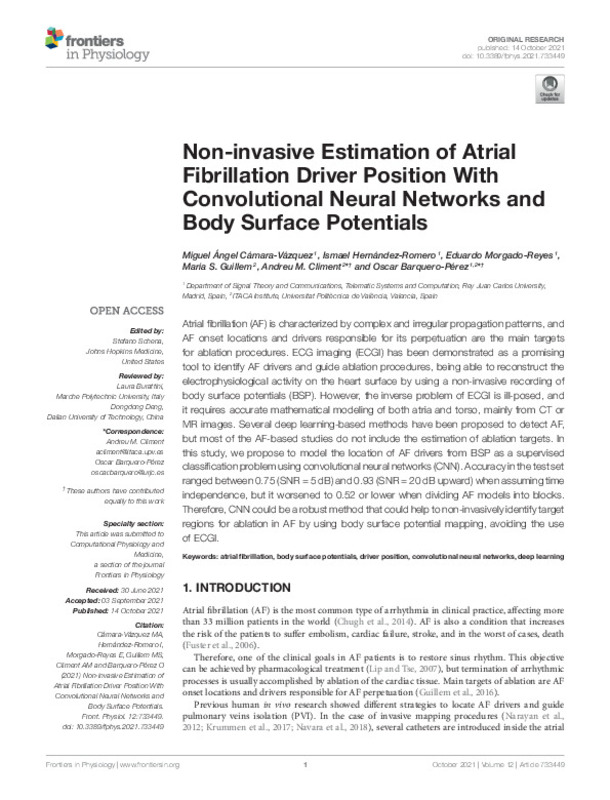Cámara-Vázquez, MÁ.; Hernández-Romero, I.; Morgado-Reyes, E.; Guillem Sánchez, MS.; Climent, AM.; Barquero-Pérez, O. (2021). Non-invasive Estimation of Atrial Fibrillation Driver Position With Convolutional Neural Networks and Body Surface Potentials. Frontiers in Physiology. 12:1-11. https://doi.org/10.3389/fphys.2021.733449
Por favor, use este identificador para citar o enlazar este ítem: http://hdl.handle.net/10251/183340
|
Título:
|
Non-invasive Estimation of Atrial Fibrillation Driver Position With Convolutional Neural Networks and Body Surface Potentials
|
|
Autor:
|
Cámara-Vázquez, Miguel Ángel

 Hernández-Romero, Ismael
Morgado-Reyes, Eduardo
Hernández-Romero, Ismael
Morgado-Reyes, Eduardo

 Guillem Sánchez, María Salud
Guillem Sánchez, María Salud

 Climent, Andreu M.
Barquero-Pérez, Oscar
Climent, Andreu M.
Barquero-Pérez, Oscar
|
|
Entidad UPV:
|
Universitat Politècnica de València. Departamento de Ingeniería Electrónica - Departament d'Enginyeria Electrònica
|
|
Fecha difusión:
|
|
|
Resumen:
|
[EN] Atrial fibrillation (AF) is characterized by complex and irregular propagation patterns, and AF onset locations and drivers responsible for its perpetuation are the main targets for ablation procedures. ECG imaging ...[+]
[EN] Atrial fibrillation (AF) is characterized by complex and irregular propagation patterns, and AF onset locations and drivers responsible for its perpetuation are the main targets for ablation procedures. ECG imaging (ECGI) has been demonstrated as a promising tool to identify AF drivers and guide ablation procedures, being able to reconstruct the electrophysiological activity on the heart surface by using a non-invasive recording of body surface potentials (BSP). However, the inverse problem of ECGI is ill-posed, and it requires accurate mathematical modeling of both atria and torso, mainly from CT or MR images. Several deep learning-based methods have been proposed to detect AF, but most of the AF-based studies do not include the estimation of ablation targets. In this study, we propose to model the location of AF drivers from BSP as a supervised classification problem using convolutional neural networks (CNN). Accuracy in the test set ranged between 0.75 (SNR = 5 dB) and 0.93 (SNR = 20 dB upward) when assuming time independence, but it worsened to 0.52 or lower when dividing AF models into blocks. Therefore, CNN could be a robust method that could help to non-invasively identify target regions for ablation in AF by using body surface potential mapping, avoiding the use of ECGI.
[-]
|
|
Palabras clave:
|
Atrial fibrillation
,
Body surface potentials
,
Convolutional neural networks
,
Deep learning
,
Driver position
|
|
Derechos de uso:
|
Reconocimiento (by)
|
|
Fuente:
|
Frontiers in Physiology. (issn:
1664-042X
)
|
|
DOI:
|
10.3389/fphys.2021.733449
|
|
Editorial:
|
Frontiers Media SA
|
|
Versión del editor:
|
https://doi.org/10.3389/fphys.2021.733449
|
|
Código del Proyecto:
|
info:eu-repo/grantAgreement/AEI/Plan Estatal de Investigación Científica y Técnica y de Innovación 2017-2020/PID2019-105032GB-I00/ES/PROCESAMIENTO DE SEÑAL PARA DATOS DEFINIDOS SOBRE GRAFOS: APROVECHANDO LA ESTRUCTURA EN DOMINIOS IRREGULARES/
info:eu-repo/grantAgreement/MCIU//RYC2018-024346B-750/
info:eu-repo/grantAgreement/EC/H2020/860974/EU
info:eu-repo/grantAgreement/CAM//S-2020%2FL2-622//RIS3/
info:eu-repo/grantAgreement/INSTITUTO DE SALUD CARLOS III//PI17%2F01106//ESTRATIFICACION Y TRATAMIENTO DE LA FIBRILACION AURICULAR BASADA EN LOS MECANISMOS DE PERPETUACION DE LA ARRITMIA/
|
|
Agradecimientos:
|
This work has been partially supported by: Ministerio de Ciencia e Innovacion (PID2019-105032GB-I00), Instituto de Salud Carlos III, and Ministerio de Ciencia, Innovacion y Universidades (supported by FEDER Fondo Europeo ...[+]
This work has been partially supported by: Ministerio de Ciencia e Innovacion (PID2019-105032GB-I00), Instituto de Salud Carlos III, and Ministerio de Ciencia, Innovacion y Universidades (supported by FEDER Fondo Europeo de Desarrollo Regional PI17/01106 and RYC2018-024346B-750), Consejeria de Ciencia, Universidades e Innovacion of the Comunidad de Madrid through the program RIS3 (S-2020/L2-622), EIT Health (Activity code 19600, EIT Health is supported by EIT, a body of the European Union) and the European Union's Horizon 2020 research and innovation program under the Marie Sklodowska-Curie grant agreement No. 860974.
[-]
|
|
Tipo:
|
Artículo
|









